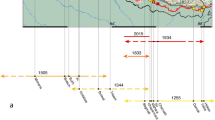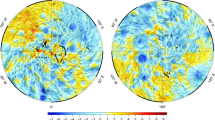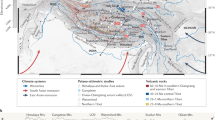Abstract
NUMEROUS orogenic episodes from late Precambrian to early Permian have shaped the Appalachian Mountains. Its last orogeny, the Allegheny orogeny, began before the end of the Lower Carboniferous and ended after the early Permian1. Most of the Palaeozoic mountain belts of Europe and other continents were worn down long ago. It is still being discussed whether the Appalachians were constantly uplifted in post-Palaeozoic times or whether there was a Cenozoic rejuvenation of uplift2–4. The composition of the Mesozoic and Cenozoic Atlantic coastal sediments and their gentle dip away from the Appalachians imply that the mountains stood as a high broad arch despite two hundred millions of years of erosion1. Geological evidence has been found and is reported here of thrusting during the past 12 yr at many locations in the Appalachian Plateau and Valley and Ridge province. Five sites have been selected in Tennessee, West Virginia, and Pennsylvania to show considerable horizontal shortening and associated vertical uplift that actually holds up the mountain ranges. The recent faulting and folding have been quantitatively studied and absolutely dated by offsets of boreholes that have been drilled for blasting operations in road-cuts.
This is a preview of subscription content, access via your institution
Access options
Subscribe to this journal
Receive 51 print issues and online access
$199.00 per year
only $3.90 per issue
Buy this article
- Purchase on Springer Link
- Instant access to full article PDF
Prices may be subject to local taxes which are calculated during checkout
Similar content being viewed by others
References
Rodgers, J. The Tectonics of the Appalachians (Wiley, New York, 1970).
Cooper, B. N. Virginia geol. Surv. Bull. 60 (1944).
Gilluly, J. Bull. geol. Soc. Am. 75, 483 (1964).
Owens, J. P. in Studies of Appalachian Geology: Central and Southern (Cloos Vol.) 417 (Interscience, New York, 1970).
Block, J. W. R. C., Clement, L. R. Lew & de Boer, J. Geology 7, 79–81 (1979).
Brown, L. D. & Oliver, J. E. Rev. Geophys. Space Phys. 14, 13 (1976).
Citron, G. P. & Brown, L. D. Tectonophysics 52, 223 (1979).
Bollinger, G. A. Bull seism. Soc. Am. 63, 1785 (1973).
Fletcher, J. B., Sbar, M. L. & Sykes, L. R. Bull. Geol. Soc. Am. 89, 1656 (1978).
Talwani, P. Geofis. pura appl. 115, 275 (1977).
Haimson, B. C. ISRM symp. 23, (Sydney Australia, Natn. Conf. Publ. 76/4, 1976).
Hooker, V. E. & Johnson, C. F. U. S. Bur. Mines Rep. Inv. 7224 (1969).
Author information
Authors and Affiliations
Rights and permissions
About this article
Cite this article
SCHÄFER, K. Recent thrusting in the Appalachians. Nature 280, 223–226 (1979). https://doi.org/10.1038/280223a0
Received:
Accepted:
Published:
Issue Date:
DOI: https://doi.org/10.1038/280223a0
This article is cited by
-
Recent thrusting in the Appalachians
Nature (1981)
-
Recent thrusting in the Appalachians (reply)
Nature (1981)
Comments
By submitting a comment you agree to abide by our Terms and Community Guidelines. If you find something abusive or that does not comply with our terms or guidelines please flag it as inappropriate.



